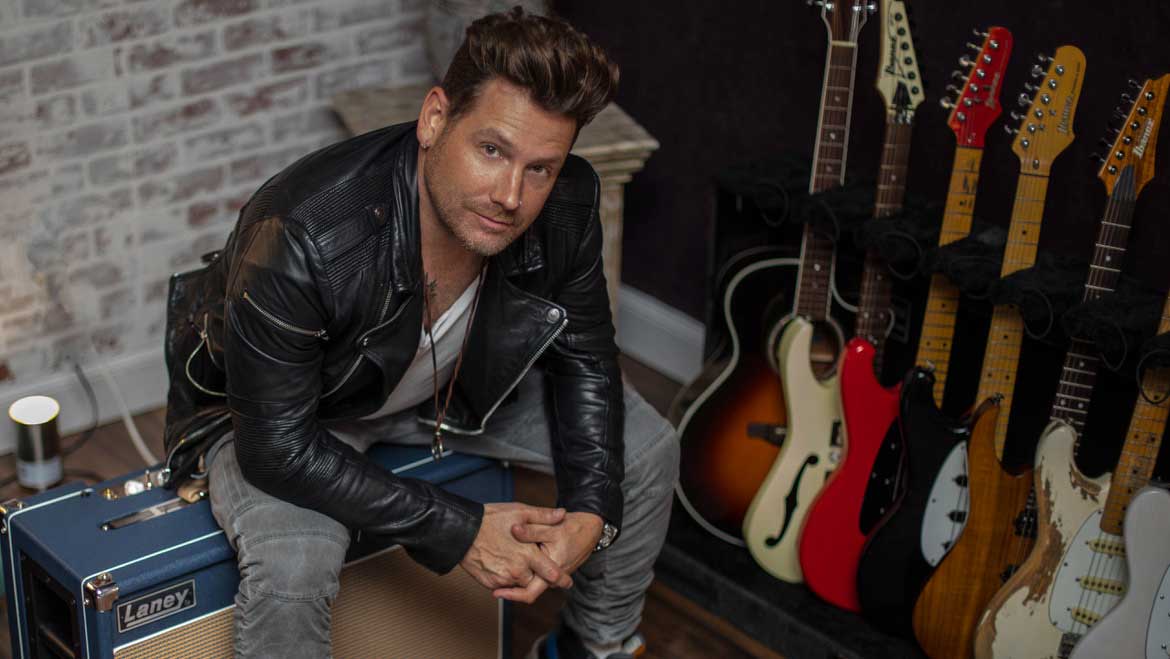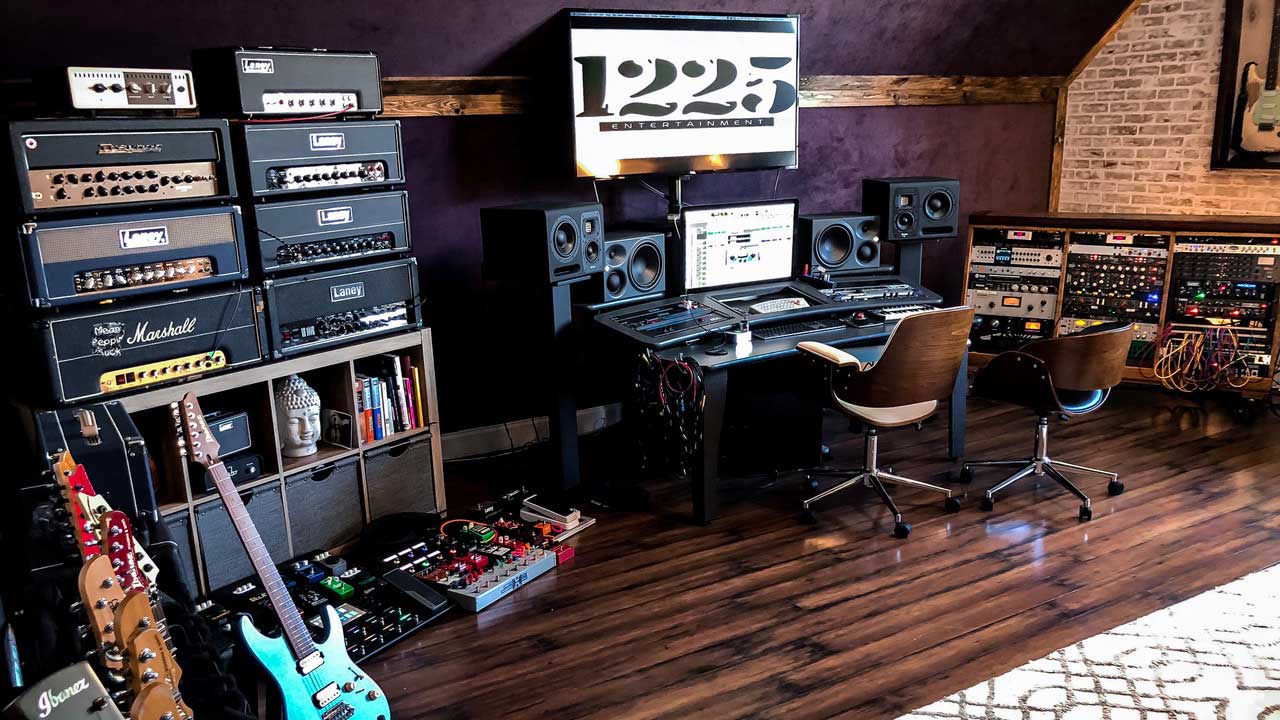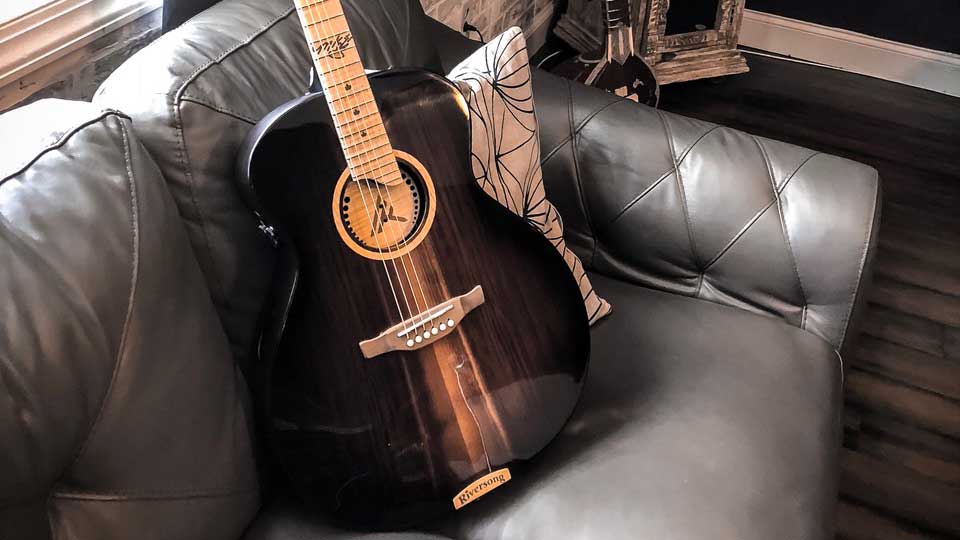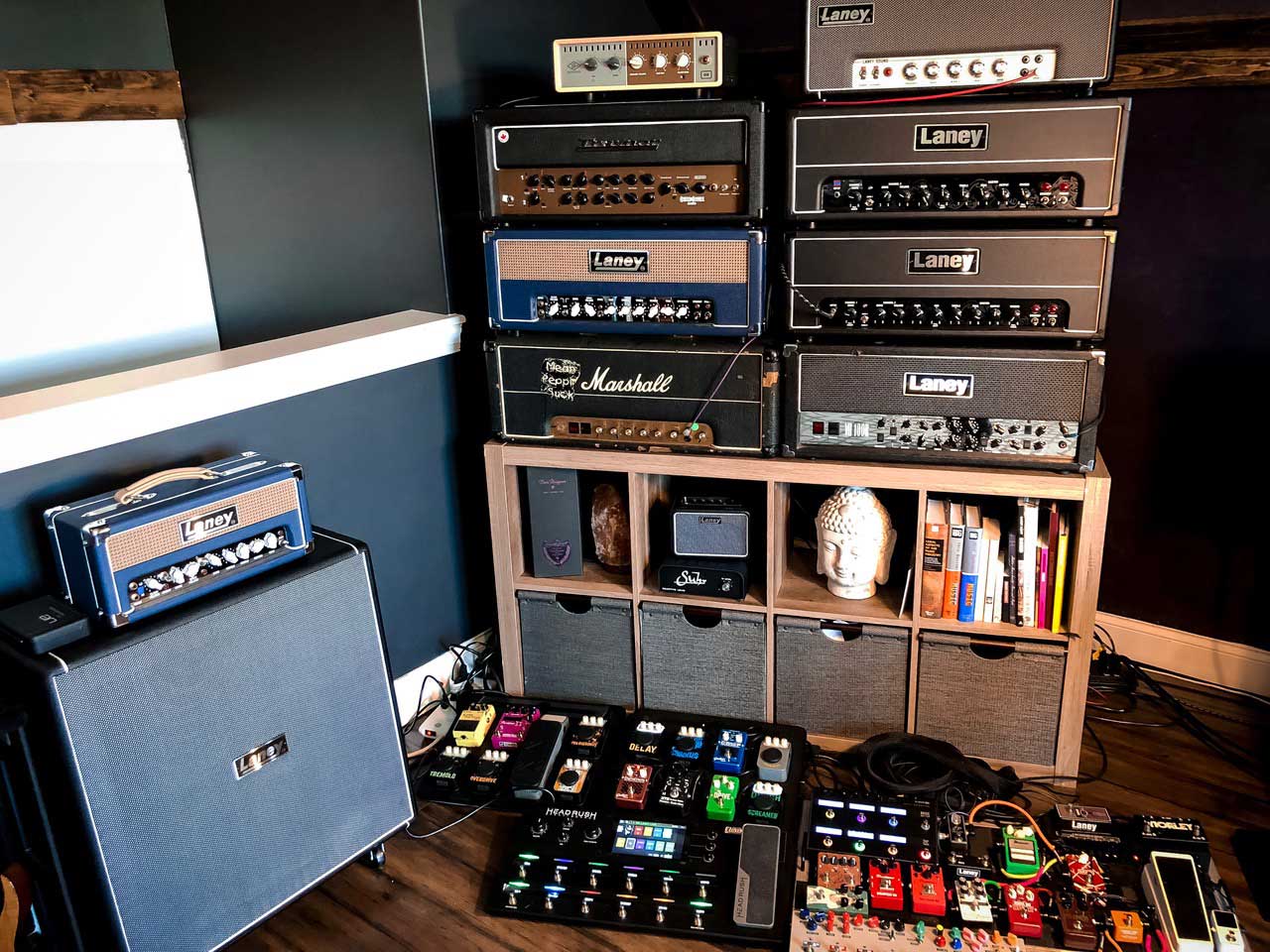Mike Krompass: "Listening to the other players is way more important than being an amazing player yourself"
Multi-platinum guitarist, producer and songwriter on studio tips, signature gear and his love of Laney amps

Like many guitarists of a certain era, Mike Krompass’s world changed when he heard Eddie Van Halen. At that moment, he knew he wanted to do two things with his life: play guitar and be a rock star.
What made him different, however, was his age at the time of this revelation: he was four. Not a four-year-old riffing to air guitar in front of the mirror, but a four-year-old playing the actual instrument and writing songs.
I guess I was born with that desire to play and sing and make up songs
“I guess I was born with that desire to play and sing and make up songs,” he says, “even if it was horrible at that age - and it probably was horrible! But it’s what I wanted to do.”
Today, Krompass is a multi-platinum guitarist, producer, songwriter, mixer, and engineer. He also plays bass, drums, and keyboards. Born in Toronto, now living in Nashville by way of Los Angeles, his journey began as a member of Grammy Award-winning artist Nelly Furtado’s touring band.
His credits include Meghan Trainor, Steven Tyler, Smash Mouth, Theory Of A Deadman, David Archuleta, Jordan Knight, Cassidee Pope, and Natasha Bedingfield - and that’s just a snapshot. In 2017, he launched rock band The Fell with bassist Billy Sheehan. This year, he and drummer Rich Redmond (Jason Aldean) created a production/songwriting/artist development company, 1225 Entertainment.
Prior to all of this, he followed a fairly typical trajectory, but did so in an atypical, precocious fashion. He gigged in cover bands - when he was eight. His bandmates were in their 40s. He worked in a music store and taught guitar lessons - at 13. His tenacity and work ethic turned each opportunity into the next as he worked his way up, and he never turned anything down.

“Anything that was music, I wanted to be a part of it,” he says, “and if I couldn’t do it, I wanted to learn how.”
Want all the hottest music and gear news, reviews, deals, features and more, direct to your inbox? Sign up here.
Upon completing tours with Furtado, and then with Canadian artist Edwin, Krompass found himself at a crossroads. So, in 2002, he applied for a visa, packed his things, and relocated to Los Angeles.
“When my stuff arrived, my computer was broken,” he says. “I had maybe $500 left after paying my rent, the monitor was going to cost $300, and I had no work. I knew I had to get out there and hustle.”
Anything I could do, I did it, to just start picking up work and gigs. I started playing with anyone and everyone
One day, the phone rang: a father seeking a producer for his adolescent son. The rising star was David Archuleta, Junior Champion on the US television program Star Search. Krompass was off and running. Archuleta went on to gain fame on American Idol, and Krompass became his producer, touring guitarist, and music director.
He also replicated what worked in Toronto: taking on every gig, recording session, and writing appointment he could schedule, working from home, onsite, and remotely, a modus operandi that continues to this day in his Nashville studio, where he took a break from his hectic schedule to speak with MusicRadar.
From the beginning, it seems you never said no to a job offer, which is smart in a business that offers zero security.
"Anything I could do, I did it, to just start picking up work and gigs. I started playing with anyone and everyone, doing tons of sessions and writing.
"I had a little studio at home, so people would call me to do tracks. I got a gig writing songs for a company called Telepictures, a music library company. We did songs for the WB, everything the Warner companies had, hundreds of TV shows. I was fortunate that I played every instrument and didn't have to hire any musicians. That was my bread and butter for a couple of years as I started to develop my artist repertoire.
"I started getting in with the labels, producing more and more, while touring and doing all that stuff at the same time. If we were playing an arena tour, for example the David Archuleta/Demi Lovato tour, while everyone else was sleeping on the bus, I would get up at 7 or 8 in the morning, set up a little studio in the dressing room or the green room and work on tracks that I had to get done. If I had a day off, I would fly in the singer, or I would fly out to go record something. I always kept myself busy."

Let’s look at a couple of key things you mentioned. One is attitude and the other is never passing up an opportunity.
People would rather be with a guy that’s a good hang, that they can be on the tour bus with, or go for coffee with, who’s fun and cool. That’s almost more important than how amazing you can shred
"People would rather be with a guy that’s a good hang, that they can be on the tour bus with, or go for coffee with, who’s fun and cool. That’s almost more important than how amazing you can shred. A lot of guys have been very successful because they’re a good person and they have good people skills.
"One thing that I think is important if you want to be successful in the business, or at least depending on how you determine success - if you want to make money, if you want to be able to feed your family - is to not limit yourself to one style, because joining the music business these days is like throwing caution into the wind. It's not a guaranteed business, there's not going to be guaranteed money, you have to be creative and think outside the box, and you have to be able to do everything."
How much time did you spend in Nashville before relocating? How did you get the gigs in a town where everyone is there to get those same gigs?
"When I first moved to Nashville about 10 years ago, I didn't try to play on everything I could or start playing in every band. I wanted to focus on songwriting, so when I came in, I went right for the publishers.
"I’m not going to lie: I had some really great friends here. Someone who helped me immensely was an amazing guy named BJ Hill, who was and still is a publisher at Warner Brothers. We hit it off, and even though I wasn't a Warner writer, he introduced me to his top writers, set me up with some things, and I met great people. Those things springboard to other situations, lead to publishing deals, and help you develop those relationships.
"I was playing in Smash Mouth when I moved here, so I was always leaving town to go play, and then I’d come back and work in the studio. But I was still doing so much work in LA that it wasn’t cost-effective to have a house in Nashville, a house in LA, and all those flights back and forth, pretty much weekly. So after the first year, I went back to LA. About two-and-a-half years ago, I moved back to Nashville. I love it here. I don’t ever want to leave."

You have a new signature acoustic guitar from Riversong. How did that come about?
"I had been searching my whole life for an acoustic that was a hybrid of my favourite guitars. I like the sound of a Martin D-28, I like the feel of dreadnought guitars, there are things about jumbos that I like, and I love parlor guitars. I wanted a unique acoustic: smaller on top of the body, reminiscent of a jumbo on the bottom part of the body, walnut, and a maple neck, which is rare for acoustics.
"I was hosting at the Laney booth at Summer NAMM, and we share the same distributor as Riversong. Everyone that works with the distributor, all the companies, were sharing this booth. We’d all go out at night, and I met Mike Miltimore, the owner of Riversong. He’s Canadian, I'm Canadian, we hit it off and were out all night geeking out about guitars.
I played all the Riversong guitars at their NAMM booth, and they all blew me away. Mike Miltimore's passion shows in every instrument
"I came by the booth the next day and picked up one of his guitars that I fell in love with. It was his own handmade one that he wasn’t selling and I wanted it really bad. We hung out the next few days at NAMM, and then I got a call from him, thanks to one of the guys that works for him, who said, 'You should sign Mike.'
"He called and said, “How about we take the guitar you like, and we customise it and build you your own model.” I was speechless. He and I co-designed it. He started sending me pictures of woods and asking what I liked. He’s so particular; he’ll go to forests in B.C. and scout out 300-year-old tonewoods. He’s like a mad scientist.
"He shared all this with me through Facebook videos, showing me how he made my guitar, and texting me pictures and explaining the properties. His excitement about building my guitar made the experience awesome and super-personal.
"I played all the Riversong guitars at their NAMM booth, and they all blew me away. His passion shows in every instrument. They’re handmade and they have unique adjustments where you can fine-tune the neck, the body, the angle of the neck, super-simply.
"A lot of people have acoustics that age and sound great, but all of a sudden the neck is like a banana and the bridge is pulling off. These guitars have unique bracings and features that make them amazingly superior."
What do you look for in electric guitars?
"I’m not one of those guys where my neck radius has to be this size, or this thick, or these things. I like certain things. I like jumbo frets. I like the back of the neck to have some weight and satin. I don't like gloss on my neck. But I have guitars with fat necks and thin necks, and I like them all.
"I’ve played a lot of guitars with alder and ash bodies, but I’m not a tonewood snob. You can pick up a guitar and it sounds great, and you can pick up the exact same one with all the same specs and it sounds terrible. So I started getting guitars that I just like the sound of, and it wasn’t for any particular reason. I do lean toward Strat-type body shapes, and I like my guitars to feel a little bit beat up.
"When I’m using single-coil pickups, I like DiMarzio Injectors or DiMarzio Areas. I like having a single-coil sound with almost the output of a humbucker and also having them silent. If I’m using humbuckers, I like PAF-style pickups. I’m completely in love with DiMarzio pickups. They have smoothness and silkiness, they’re not too scooped, and they have really nice mids.
A lot of sessions have to be played a certain way to be radio-friendly. With this band, we do what we want
"I like across-the-board smoothness, where the pickup output is not too hot, but it’s also not too low output that you can’t get any scream out of it. I think mids are important because I like that sound of when you’re playing solos and you can hear the pick attack, and I think they enhance that perfectly."
"For strings, I’m with D’Addario. I use typically 10s and regular gauge; they stay in tune the best, in my opinion.
"I’m endorsed by Ibanez. My main guitar for the last couple of years has been the Prestige Talman, and I’m in love with the old Roadstars. I Frankenstein them and change the pickups. I’ve also got an Ibanez AZ. The neck’s fabulous because they’re wider and a little bit fatter; they have that satin feel, and they sound great.
"I’m not a big whammy person; if I have a guitar that has Strat-style trem, I tighten all the springs, and if there’s a whammy that goes both ways, I’ll block it. I have a couple of guitars for that, if I need a whammy bar, but usually I like to play a guitar that’s super-stable, so that if I break a string it’s not going out of tune."

How do you like to record guitars?
"I usually have a large diaphragm mic on my cabinet, with a smaller, more focused mic like a 57 or an SM7, and then sometimes a ribbon mic and a couple of room mics. But I’m one of those - and don’t hunt me and kill me if you’re reading this! - I’m a tube amp guy.
I’m not really a Kemper guy, I’m not a modeller; I like tube amps, that is my thing, and I have a huge rack of them
"I’m not really a Kemper guy, I’m not a modeller; I like tube amps, that is my thing, and I have a huge rack of them, but now I do a bunch of speaker emulation, so I do impulse responses of all my speakers. I mic them up and capture them, and then A/B them for what the actual speaker sounds like.
"I use a Suhr Reactive Load box, and on my heads I have models of my Greenbacks, or models of my different cabinets that sound, to me, very close to if not identical to them. It makes recording easy.
"I’m sitting my control room now with eight heads that are all wired up to go to two different reactive load boxes that I’m switching between. I go from that into a Neve or Chandler pre, and then I've put my impulse response of whatever cabinet I want. Because it’s super-quick, I can switch my speaker right after, if the tone’s not working. So that's my new thing.
"Every once in a while I still mic a cabinet, and my go-to is a 57 or SM7, either one, and a Neumann u87 or m149, or something with a larger, warmer condenser on one speaker, and then, right off it, sometimes I put a ribbon mic; I love the Cloud 44A. But lately recording has all been in the box and not even going out to a cabinet."
You have a longstanding relationship with Laney. What do you like about their amps?
I pretty much have every Laney that’s out there. I love them. They give you everything you need
"I pretty much have every Laney that’s out there. I love them. They give you everything you need. There are two heads that are my favourites in the whole world right now. One is the Laney LA 30BL with EL34 tubes. It’s basically like a Plexi, and it’s the 30-watt recreation of the ’60s version of the original amp. It sounds phenomenal. My other go-to amp is the Laney GHR 100. That's what I like to use live and in the studio. Those are my two main heads.
"The EL34-based head gives me that vintage Marshall-ish sound, or on the clean side that similar Fender warm sound. Pretty much you can dial in any tone. They’re so warm and fat, and they don’t get fuzzy in the high=end. They have that perfect, sweet, warm spot and they don’t sound too harsh or brittle.
"They’re flexible in their design, the ones I like are super-simple, and they have cool features like speaker emulation out, so you can run a direct line to a Pro Tools rig and record. They’re reliable and durable and they sound monstrous.
"My Laney GHR 100 annihilates in volume. It’s unbelievable how tight and loud it can sound. And the tone - as you turn them up, the tone doesn’t change. They sound better. The sound doesn’t degrade. Some amps at a certain level lose their bottom-end and their tightness. These things can rip your face off and it’s super-tight. That goes for the cabinets, too. They’re tight on the bottom-end.
"And they're amazing people. Their gear speaks for itself, but when I met them, they treated me as if I had known them for 20 years, and when they sent me my first amp, I was blown away. That was about three years ago, and I’ve been exclusive with them for two years."
What else is integral to your sound?
"I have a ton of different things in the studio. I use BAE mic preamps for recording guitars, drums and vocals. They’re my go-to mic pre.
"HeadRush gave me one of their 'boards. It’s plug in and go, and it has great clean sounds, great effects and perfect in the FX loop for me. I have tons of analog pedals. My main pedalboard is pretty simple. I have a wah, a Henretta Orange Whip, which is my favorite compressor ever, a TC Electronic Mojo Mojo overdrive, which is my go-to on all my pedalboards, an EBS Drive Me Crazy distortion, a Laney TI Boost, and everyone has to have a Tube Screamer.
"I also have a Henretta Eight Speed; they make amazing pedals. They put eight pedals into one little thing and you can put it in a backpack and fly with it. It’s all analog pedals, so I put my favourite compressor in there, it has a dirty boost, reverb, and some chorus things.

"The NEXI 'boards are amazing. You can pull the pedals off, and you can integrate your own pedals. I have two of those 'boards, which house eight pedals each.
"Their pedals are fantastic. The Dutch Screamer is kind of like a Tube Screamer, but it’s got its own thing too, their Analog Chorus is one of the best-sounding choruses, their straight-up Delay is great, they’ve got a ’70s Overdrive that I use all the time, and with those 'boards I can integrate my own pedals too.
"I have an XTS Custom Precision Multi-Drive, an EBS DynaVerb, so my heads that don’t have effects loops, I have a DynaVerb on the front end, the new Providence overdrives are super-cool, I have some old vintage Super Overdrives, a variety of different-sounding wahs - the NEXI wah is fantastic if you want that extra midrange thing; I have that in the studio all the time - and my go-to wah for the big rock sound is the Cry Baby."
You started a company with Rich Redmond. What’s the story?
A lot of sessions have to be played a certain way to be radio-friendly. With The Fell, we do what we want
"Rich is like my brother and soulmate. I met him about two years ago, when he came over with an artist I was producing. He had co-written a song and she wanted him to play drums on it. He was the most positive guy - his energy is addictive. We connected instantly. We have a production company starting to kick some ass, we’re starting a new label, and we’re signing great upcoming talent.
"I usually don't need drummers to play on records anymore because I do it myself. But when we work together, we have chemistry. He’s a great player, a fantastic guy, he has so much soul, and he knows everybody. I don’t think there’s a person in the world who can say anything bad about Rich. He’s so liked and well respected, and he has the best attitude I’ve ever seen."
What’s going on with The Fell? You toured last year, but it’s been quiet lately.
"I’m super-excited: we just started working on our album! It’s Billy Sheehan on bass, Rich Redmond on drums, my studio assistant Scott Westervelt on keyboards, myself, and vocalist Stephen Vickers. I’m writing the record with some of the band and I’m producing it. We’re planning on an early 2019 single release.
"A lot of sessions have to be played a certain way to be radio-friendly. With this band, we do what we want. If there’s a crazy bass thing, that’s okay, because we’re doing it for the fun and the love of it, not for commercial success. And I get to play guitar solos! How cool is that?"

What else are you working on?
"Mr Big and Talas have records they’re talking about making, so I’m bugging them to have me produce them, Smash Mouth is going to do another single, and I’m working on stuff with Rich. We’re developing some artists, writing, tracking, and we’ve got some production projects to wrap up."
What do you listen for when you produce?
The most important thing in the studio is not how well you can play solos; it’s your rhythm
"Excitement. The feel, the tone, and the passion. That's the main thing, and making sure they’re rhythmically good. The most important thing in the studio is not how well you can play solos; it’s your rhythm. I’ve seen so many guys that can rip the most amazing solo, but their timing is horrible.
"It’s important for any musician, if you want to be a studio guy, to have impeccable timing and be rhythmically solid, and really pay attention to drums and what the kick-drum pattern is doing. It can open the track up a lot more if you’re dead-on tight with those drums. Obviously, if you’re doing something grungy or a little bit more rock, where you want to be on top, that’s a different thing. But generally speaking, I lean toward guys who are rhythmically tight.
"Dynamics are super-important. When there’s a build from an eighth-note fill or something like that, it’s important to hit that first downbeat hard; those kinds of things give the track life. Staying in the pocket, and the connection between guitar and drums, the hi-hat pattern and the kick-drum pattern, the feel of the drummer and being able to match that feel, will makes your track sound so much better.
"It goes back to the first thing we talked about: learning different styles, learning pockets, and the 10,000 hours you have to put into learning your craft. People always try to fast-track it, but it's important to learn music, even if you’re not a sight-reader or a theory guy, to study music and how it moves. That is always helpful. Listening to the other players is way more important than being an amazing player yourself, and it will help you become an amazing player."